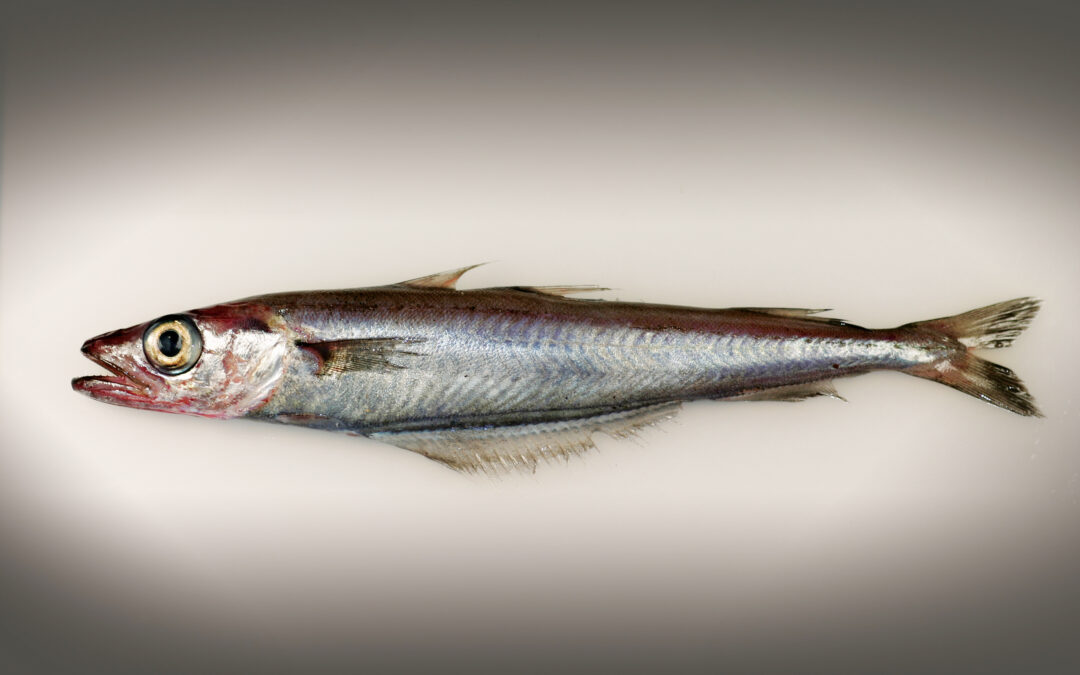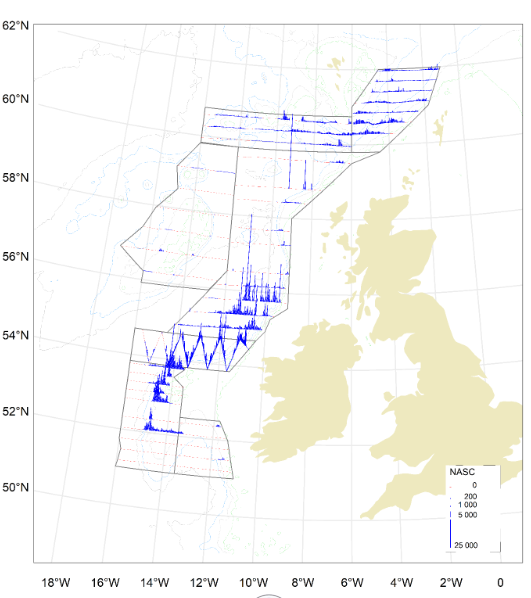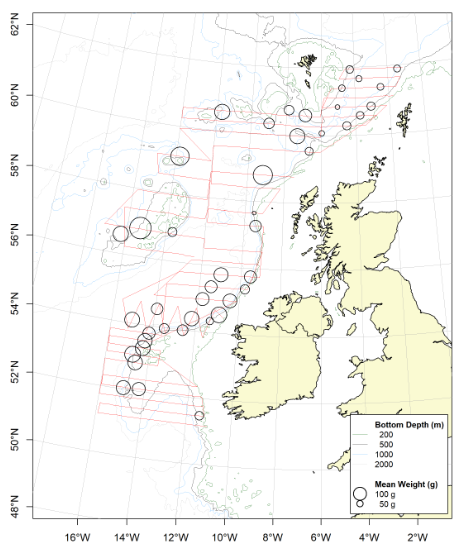INTERNATIONAL BLUE WHITING SPAWNING STOCK SURVEY (IBWSS) 2022
by Ciaran O’Donnell
Fisheries Ecosystems Advisory Services (FEAS)
In March the RV Celtic Explorer took part in the International Blue Whiting Acoustic Survey. This survey estimates the size of the spawning stock of blue whiting (Micromesistius poutassou) in western waters and is conducted by vessels from Ireland, the Faroe Islands, the Netherlands, Norway and Spain. The survey is an important source of information for the annual ICES stock assessment. Ireland has participated in this survey since 2004.
Area coverage
The Celtic Explorer began surveying on the 23rd March, along with vessels from the Netherlands (RV Tridens), Norway (FV Vendla), the Faroe Islands (RV Jákup Sverri). In combination, this ensured almost continuous synoptic coverage over 15 days from the Porcupine sea bight northwards to the Faroe/Shetland Ridge including Rockall and offshore banks south of the Faroes (Figure 1). The combined survey effort covered over 5,800 nmi (nautical miles) of transects representing 126 thousand nmi² of spatial coverage. The spatial coverage, survey effort and timing were comparable to the 2021 survey.
Each of the vessels followed a predetermined survey grid, working in a northerly direction, with the combined coverage providing high resolution transect spacing. Survey scientist Ciaran O’Donnell said “this year the bulk of the stock was located to the west and the north of the Porcupine Bank, which is a little further south than seen at the same time last year. Blue whiting were also found further west than observed in recent years, with mature fish observed to the west of the Rockall Bank”.
Stock distribution
The spawning distribution of blue whiting is influenced by the North Atlantic Sub-Polar Gyre, a large body of relatively cool, fresher water of northern origin. The size and strength of the gyre varies over time, changing the hydrographic conditions in the Rockall region. During spawning, blue whiting seek out suitable areas of stable, high salinity water. In years when the gyre is strong the effect is to restrict spawning to areas along the shelf edge as fish seek out suitable habitat provided by the relatively narrow northward flowing shelf edge current. Conversely, in weaker gyre years, Atlantic waters dominate and suitable spawning habitat expand westwards through the Rockall Trough and Rockall Bank providing an extended spawning habitat.
The trend in recent years (2020 onwards) has seen a weakening of the gyre and this continues into 2022 and is reflected by the expansion westward distribution of Blue Whiting in the Rockall Trough and to the west of the Rockall Bank.
In 2022, the survey indicated that the bulk of the stock was located within the three survey strata bounding the shelf edge; Porcupine Bank, north Porcupine Bank and the Rockall Trough (Figure 1). When combined, these strata accounted for 83.5% of the total observed biomass (similar to 2021). The Rockall Bank, South Faroes and Faroe/Shetland Channel strata accounted for 16% of the total biomass. The Porcupine Seabight stratum, which was extended southwards in 2021 to ensure containment of the stock on the southern boundary, contributed the remaining 0.5% of the total observed biomass.
The main body of the stock in 2022 was detected to the west and north of the Porcupine Bank. As in previous years, the largest aggregations of blue whiting were found distributed along the shelf edge. However, high density aggregations extended as far as 50 nmi into the Rockall Trough in 2022, which is in contrast to recent years. The northernmost survey strata are historically dominated by low numbers of immature blue whiting to the east and west of the Faroe Islands and in the Faroe/Shetland Channel. The 2022 survey detected significant numbers of both immature and maturing (1 & 2-year old) fish – greater than that previously observed in the survey time series.
Stock composition
The age composition of the stock was determined from 47 trawl samples taken during the survey (Figure 2). Trawl samples yielded 2,372 individual blue whiting age measurements ranging from 1 to 14 years old and 6,499 length measurements. The main contribution to the biomas was from age groups 2, 4, 3 and 5 years, respectively. In combination, these age cohorts represent 69% of total stock biomass (TSB). In terms of total stock numbers (TSN), 2-year-olds (2020 year-class) were most abundant (30%), followed by the 4-year-olds (17%), 3-year-olds and 5-year-olds (8%) respectively. Immature fish represented 12.6% of biomass and 23.8% of TSN. Over 71% of the 2-year old fish were mature and therefore contribute to the spawning stock.
Stock size
The total stock estimate of blue whiting for 2022 saw an increase of 15% in TSB and a corresponding 56% increase in TSN compared to 2021, with comparable survey effort and coverage. The increase in the 2022 estimate is largely driven by the abundance of the maturing 2020-year class. Indications are that this year class appears to exceed that of the record 2014-year class.
The IBWSS survey is a spawning stock survey, recording the abundance of mature fish on the spawning grounds. The ability of the survey to identify emerging year class strength is limited until they begin to recruit to mature spawning population as 2-year old fish.
O’Donnell added “the IBWSS survey recorded a high number of 1 and 2-year old fish in the northern area in 2022, the abundance of which were notably higher than we have seen in recent years. Surveys to be carried out in the Norwegian Sea this summer will provide further insights into the strength of the 2021-year class before they emerge as mature fish during the blue whiting survey next year”.





Recent Comments